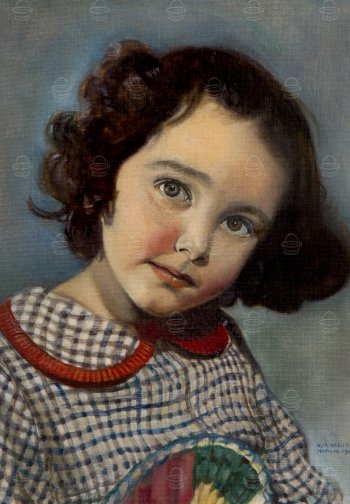
Kadish was primarily a painter in oils. His chief interests lay in portraiture and figurative work. He studied the Old Masters, especially Titian, Velasquez and Rubens. He also admired the pre-Raphaelites and Victorian and Edwardians such as Alma Tadema, John Singer Sargeant, and Augustus John (a patron of his father’s tobacconist shop), at a time when these artists were considered old-fashioned.
NMK preferred to paint from life. At art school he excelled in figure drawing, painting and composition for which he won a couple of medals. In his day, students of fine art were expected to study antiquity and anatomy in order accurately to depict the human body. Life Drawing classes regularly featured models, both male and female, either clothed or nude. He continued to draw and sketch throughout his life, whether at evening classes that he ran in Edgware and Hampstead, or attended in retirement at the Royal Academy Schools. He used to carry a pocket sketchbook and pencil when he was travelling on the London Underground so that he could capture fellow passengers standing, sitting or sleeping in various poses, which he did with great speed and dexterity.
He made drawings from life for his two large peopled Paintings The Lambeth Walk and Britain by the Sea. Undoubtedly, these were his Masterworks and were meticulously researched. By the time he embarked on his narrative Biblical Cycle in the late 1960s and early 1970s, he was also taking photographs of his models. He would scale up his most complex compositions into cartoons and then transfer them to the easel. While the canvases tended to get smaller, the preparatory working methods and the handling of the paint became freer in the artist’s mature years.
He painted Portraits of his immediate family, of his wife Renée and their daughters, sometimes of friends or models, and occasionally undertook a commission.
His range of subject matter was very varied and demonstrated his huge versatility [see Paintings and Drawings]. He drew inspiration from contemporary life, the environment where he lived or holidayed, such as shoppers in North London, railway stations and the seaside at Eastbourne or Jersey, often including boats. There is also a recurrent theme of nostalgia running through his work, especially for the fictional English public school of Greyfriars and its hero Billy Bunter, created by Frank Richards (Charles Hamilton 1876-1961).
NMK was always less interested in painting inanimate objects, places or nature than people. Nevertheless, his output included land and seascapes, in which he made a skillful study of light, land and water. He also produced still lifes, whether rendered with old master accuracy or in impressionistic and vibrant colours.
NMK was strongly attracted to the world of commercial art where accurate life drawing of people remained in demand after World War II. His War Sketches had been essentially illustrative. He particularly liked the American graphics painter, his namesake Norman Rockwell and, no doubt, would have found work in a film studio had he gone to Hollywood. (His younger brother Esmond’s [Esmond Arnold Kadish 1923-1989] talents lay in music and scriptwriting). Norman Kadish produced what are now considered vintage movie posters, advertisements, book and magazine illustrations and comic strips. Over time, he experimented with a variety of media: poster paints, gouache and acrylic. He drew in pencil, pen and ink, crayon, charcoal, chalk and pastels, sometimes in combination within a single work, but use of watercolours was rare.
He also worked in various crafts, especially bookbinding, and delighted in the use of fine materials: dyed leathers, marbled end papers and gold leaf. His tooled book jackets often featured the most original designs.